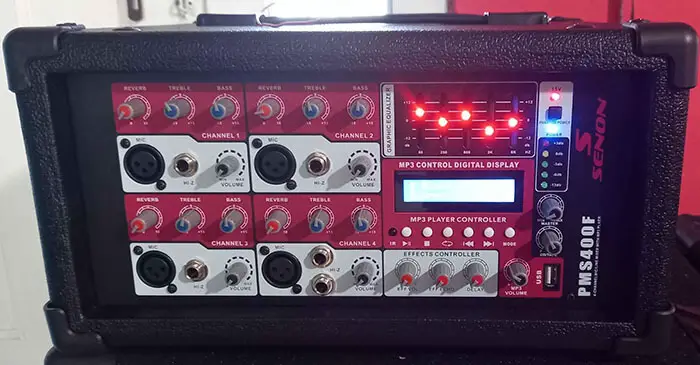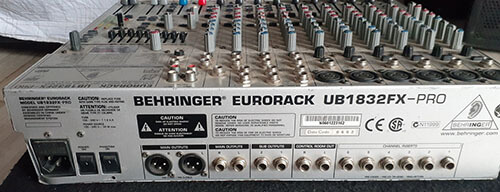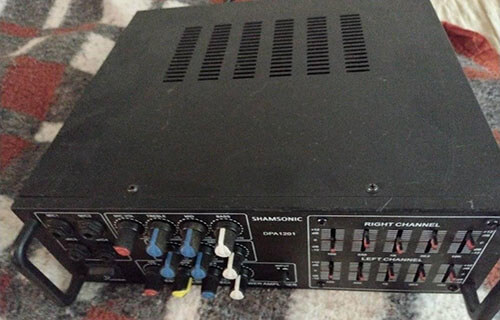Hey there,
When my amplifiers stopped working the first time, I thought the fuse/transistor of my amplifier was damaged.
Because I left my amplifier on all the time and continuously used it for a long period.
But there was another issue.
Today I will tell you how I fixed the problem with my amplifier and solved it.
So, let’s start the main discussion.
6 Common Reasons Amplifier One Channel Not Working

Some common problems occur with your amplifier, like no sound coming from the amplifier, although it has power but is not working, distorted sound, etc.
And if your amplifier loses its power, then it stops working also.
So, let’s see for which reasons amplifiers stop working properly.
1. Improper Speaker Connection:
One of the most common reasons behind amplifier failure is improper speaker connection.
If anyhow mixed up the positive and negative speaker wires and destructive interference occurs, it makes no sound issue.
2. Rust and Wired Connection:
If the jack of your amplifier is heavily affected by the rust, it will fail to deliver the proper signal. However, there is enough power on your amplifier.
And if the wire isn’t connected with the amplifiers properly, the same problem occurs.
3. Over-current:
When the output transformer remains open or faulty because of over-current, then your amplifier will stop working.
If there are short circuits on your amplifier to connect the wire to your speakers or receiver improperly, the overcurrent occurs. And the amplifiers stop working.
Excessive load ground fault and arc fault are other reasons for the over-current effects of amplifiers.
4. Over-voltage stress:
Over-voltage stress is another cause for the faulty output transformer and failure of amplifiers.
And because of lightning impulses, switching impulses, insulation failure, arcing ground, and system resonance, your amplifiers get faulty and stop working.
5. Blown Fuse:
Blown fuse would be a reason for the Amplifiers channel to stop working. Again, If the speaker’s wire of your amplifier shorts out, then it will stop working.
6. Power Loss:
If your amplifier loses its power for natural reasons like loose connections, corrosion and shorted-out spots, etc., then the amplifier of your device won’t work.
Quick Fix Tips
Disconnect the speaker wire from the jack port. I am using an electrical contact cleaner spray, clean input jacks, and speaker terminals.
You can use WD-40 Electrical Contact Cleaner Spray for cleaning the Oil, Dirt, Flux Residue from your amplifier’s speaker wires and port.
If there is only dust on jacks & wires, use a can of compressed air to ensure blowing the dust away from electrical components.
And after cleaning the dirt, connect the wires in the jack port again.
How To Fix An Amplifier That Is Not Working

Solution 1: Plug the wires in the reverse position
When any of your speaker wires stop working, remember which one (left or right) is not working.
By comparing the components and voltages, you can distinguish between the dead and good channels.
So that you can identify the bad component that is needed to replace.
After indicating the specific wire, try this process.
First, turn off your amplifier. Then unplug the right and left speaker wire of the amplifier.
And remember which one is the right and left-sided wire.
Now plug them in reverse position, the left-sided wire to the right side and the right-sided wire to the left.
If the previously indicated wire /speaker is not working, it is final that this speaker or wire is bad. If the other-sided wear stops working, it is a problem with your amplifier/fuse/other components.
If your speaker wires are bad, the wire will come loose from the terminal. Or you can use a multimeter to check the speaker wire.
For testing the resistance of the wires, you have to connect the end of every single wire to the positive and negative leads of the multimeter.
If the speaker measures very low / very high/ no resistance, then it is bad, and there is a broken connection in your speaker wires.
Then you need to repair the wire of your amplifier’s speaker.
You can use Innova 3300 Hands-Free Digital Multimeter for checking the connection easily.
Now is the term if your right/left channel wire doesn’t work, then you will fix it.
Repair the wire:
Step 1:
First, cut the covering tape upon the right/left wire (that isn’t working) and uncover the speaker’s wires.
Pull the twisted wires apart. As like this,
Step 2:
You will find some shrink tubes there.
Besides, You will find two kinds of wear between the cable, red/ golden as positive and black as negative.
You need to re-cut and re-strip them now.
Step 3:
Now it is time to twist the bad colored wire to the opposite black wire and the same process for the golden/red wire.
Step 4:
After twisting wires, you can use a solder pin and solder gun to provide heat to the joining of the twisted wires. This process is useful for solder joints there.
Step 5:
And at last, cover-up the tape of the wire.
If your speaker wire is short, it will be best to use a 16-gauge wire. And for longer speaker wire, it will be best to use a thicker, lower-gauge wire.
After repairing the wire of your amplifier, it will need advanced troubleshooting if it doesn’t work.
Solution 2: Troubleshooting

Troubleshooting is an easy and quick process for immediately detecting and fixing an amplifier’s bad issues.
After trying the reverse wire plugging, troubleshooting can be the solution if the problem doesn’t fix.
So, let’s start to try.
Process 1 (Simplest Process):
Sometimes, it occurs that your amplifier is not, but there is no sound in it.
Most of the time, this problem creates a bad connection of wire, wire losing, etc.
Then you should unplug and replace the wire, detach the speaker from your amplifier, and fix the problem.
Otherwise, follow the second step.
Process 2:
If your amplifier isn’t grounded properly, it can turn off suddenly, overheat, permanent damage, etc. It isn’t an overnight process.
If you keep your amplifier turned off, remove one of the ground paths. After this, attach the wire to the best grounding source.
an 18″ long cable is suitable for your amplifier’s ground cable. After this, if it doesn’t fix, follow the next step.
Process 3:
Operator error can stop the sound of your amplifier, even if it is lightning up.
Then check whether the speaker wire is connected with the speaker or not. If you don’t select the speaker button, this operator error can also occur.
Select the speaker button and test your amplifier.
Process 4:
The half-splitting method is a good fit for finding the fault and defect of your amplifier. It helps to trace signals, ground faults, etc.
The half-splitting method will help to know the absence or presence of a signal.
And you can be able to know whether the signal is absent/present in the first halfway / last halfway between the input and output.
Solution 3: check your amplifier is in protection mode or not
The amplifier can protect from internal damage. Sometimes it goes in protection mode because of overheating or lack of airflow / blown fuse/ faulty elements, and so on.
You need to check it off whether it is in protection mode or other internal damages have occurred in it.
Some symptoms you can see when the amplifiers are in protection mode, like,
- The simplest symptom of protection mode is the power light will not illuminate at the shutdown state
- The power light blinks and then go off
- Your amplifier will shout down simply
If you notice these types of symptoms in your amplifiers, try these steps to get your amplifier out of protection mode.
Quick Fix for protection mode:
First, unplug the speaker wire and head unit. Depart power from the amplifier.
Add some ventilation and airflow near the amplifier. Keep it in this position for 15 minutes to keep it cool.
After 15 minutes, plug the speaker and head unit. Attach with power and turn it on.
If it doesn’t fix, you have to replace some components in your amplifier.
Use a cooling fan to avoid overheating: Solution 1 for fixing protection mode.
When using it, if your amplifier gets too hot, overheating can be the main reason behind the protection mode of your amplifier.
If your amplifiers are set in a place where ventilation and airflow are very low, try to add ventilation and airflow.
If the airflow is not enough to cool it down, then attach a cooling fan to your amplifier.
I have been using the AV cabinet cooling brand’s cooling fan for two years. It has a lower noise level and good airflow capacity, which is beneficial.
There can be wiring issues for this protection mode, like shor ground wire.
Use a standard ground wire: Solution 2 for fixing protection mode
If the ground cables of your amplifiers are too small, then it won’t get the proper power that it needs.
Then it will try to make extra power and get too hot.
As a result, thermal shutdown can occur in your amplifier to protect the components.
If you use a 200-amp it will be best to use 8 AWG of Copper grounding wire / 6 AWG of Aluminum.
Defective output transistors can make your amplifier. For short circuits, open circuit transistor failure occurs.
Solution 4: Fix a short circuit in your speaker
First, you have to turn each loudspeaker around. Check the terminals on the back of the units and look.
If any wires connect the positive and negative terminals “can” at that point, it means there is a short circuit in your speaker.
Now, remove the wires. Reconnect them again.
Always try to unplug electronic devices when you don’t use them. It is the best prevention for keeping safe from short circuits.
I want to tell you that I discovered a problem with my amplifier in this step. There was a short circuit in between the speaker wires.
After testing all this process, don’t be disappointed if you can’t fix your problem.
Check the fuse of your amplifier.
Solution 5: Test the transistor
Remove the transistor from your circuit board.
Base to Emitter Check using ohmmeter:
For NPN transistor:
Using an ohmmeter, you can easily test your transistor.
Place the positive lead/probe of your ohmmeter to the BASE (B) of the transistor.
Then place the negative probe to the Emitter (E).
A good NPN transistor will show the connectivity.
For PNP transistor:
Its process is vice versa.
Place the negative lead/probe of your ohmmeter to the BASE (B) of the transistor.
Then place the positive probe to the Emitter (E).
For a good PNP transistor, it will show no connectivity.
Base to Collector Check using ohmmeter:
For NPN transistor:
Place the positive probe to the BASE (B) of the transistor.
Then place the negative probe to the Collector (C).
A good NPN transistor will show connectivity.
For PNP transistor:
Its process is vice versa also.
Place the negative lead to the BASE (B) of the transistor.
Then place the positive probe to the Collector (C).
For a good PNP transistor, it will show no connectivity.
Test using a Multimeter:
You can test your transistor using this process with the help of a multimeter also.
Base to Emitter checking:
For Base to Emitter checking, place your multimeter’s positive lead/probe to the BASE (B) of the transistor.
Then place the negative probe to the Emitter (E).
For a good NPN transistor, you can see the voltage drop between 0.45V and 0.9V, and for PNP transistors, “OL” (Over Limit).
Base to Collector checking:
Place the positive lead/probe of your multimeter to the BASE (B) of the transistor. Then place the negative probe to the Collector ( C ).
For a good NPN transistor, you can see the voltage drop between 0.45V and 0.9V, and for NPN transistors, “OL” (Over Limit).
If your transistor isn’t okay, you need to repair or replace the transistor.
And if it is ok, you have to check the fuse.
Solution 6 : Fuse Testing and Replacing
Your amplifier won’t turn on if the fuse is blown. And the reason behind this is, the circuit providing mains voltage is open or any internal damage.
In this case, you will need a small screwdriver to unscrew the fuse holder cap.
After uncovering the holder cap, look at the fuse wire.
If you find any visible gap in the wire / a dark /metallic smear inside the glass, the fuse is blown and needs to be replaced.
How to Change a Fuse of an Amplifier:
Step 1:
At first, using a screwdriver, unplug the fuse holder. Just push up and twist. Then the fuse will come out.
Step 2:
Using a multimeter, check the voltage of your fuse. Just touch both sides of your fuse (with the two messing leads) and check the multimeter screen. Like this,
If it goes close to zero, then it is good, otherwise not.
Step 3:
It is the term to plug a new fuse into the fuse holder.
A fast blow fuse is better than a slow blow fuse. Because the fast blow fuse can disconnect the circuit immediately as soon as the overcurrent is detected.
For 16 gauge amplifier wire, 7.5 amps fuse is a good fit.
Here you will get different types of amplifiers in Amazon, that you need, like 5, 7.5, 10, 15, 20, 25, 30 AMP Mini and Small ATM/APM Blade Fuses,
Step 4:
At last, you have to set the fuse to the fuse holder.
Frequently Asked Questions
How long can amplifiers last?
A solid-state and Tube amplifier naturally lasts for 30 years, even if you use it regularly.
But you need to re-tubing the tube amplifier after every 2 years. An audio amplifier lasts for 10-20 years.
Should you leave your amplifier on all the time?
It is safe to turn off your amplifier when you aren’t using it.
But if you use high-quality and powerful amplifiers like hybrid MA12000 Integrated Amplifier, Crown XLS1502 Power Amplifier, you can leave it on without any internal damage.
But other amplifiers are not safe to leave it on because of heat exposure issues. That shortens the lifespan of the tube and damages other parts also.
Please leave it for 1 hour to keep it cool after 6-8 hours of continuous use.
How many speakers can I connect to a 1 channel amp?
You can connect two speakers as parallel and series to a 1 channel amplifier.
Which amplifier is best for audio?
Onkyo A-9110 (50W/4Ω), Anthem STR (200W/8Ω), Cambridge Audio CXA61 (60W/8Ω) are some best amplifiers but are costly also.
Can an amplifier be repaired?
It is not possible to repair amplifiers because of their delicate component issues. But it can be replaced.
Conclusion
Hopefully, this process has helped you a little bit or can be more. I have tried to tell you those steps to fix my issues.
Finally, I want to give a suggestion that will be helpful for your amplifier: always try to use your amplifier for the highest 8 hours, and it is better if you can use it less than that.
Keep it off when you don’t use it to avoid internal damage and heating issues.
